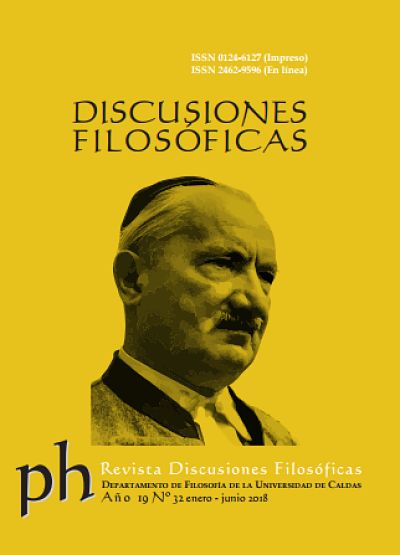Authors
Abstract
This paper defends that the theorization on the capacity for joint attention must clarify the concepts of experience and intention: a purely philosophical enterprise. The text exposes the main psychological aspects of the capacity, the most relevant theories on it and philosophically analyses the subject. It is concluded that there is no mature consensus among theories about the operational and functional role of joint attention, and that the immaturity of the theory rests on a deficient elaboration of the main concepts of intention and experience, a task in hich philosophy makes a significant contribution.
Keywords:
References
Baron-Cohen, Simon. Mindblindness: An Essay on Autism and Theory of Mind. Cambridge: The MIT Press. 1995. Print.
---. “The Eye Detection Detector (EDD) and the Shared Attention Mechanism (SAM): Two Cases for Evolutionary Psychology”. Joint Attention. Its Origins and Role in Development. New York: Lawrence Erlbaum Associates. 1995. 41-59. Print.
Bruner, Jerome. Child’s talk. Learning to Use Language. New York: Oxford University Press. 1983. Print.
---.“From Joint Attention to the Meeting of Minds: An Introduction”. Joint Attention. Its Origins and Role in Development. New York: Lawrence Erlbaum Associates. 1995. 1-14. Print.
Butterworth, George. “Origins of Mind in Perception and Action”. Joint Attention. Its Origins and Role in Development. Nueva York: Lawrence Erlbaum Associates. 1995. 29-40. Print.
Carpenter, Melinda, et al. “Social Cognition, Joint Attention, and Communicative Competence from 9 to 15 Months of Age” Monographs of the Society for Research in Child Development, 63 (4). 1998: 1-174. Web.
Casasanto, Daniel. “Linguistic Relativity” Routledge handbook of semantics. New York: Routledge, 2016, 158-174. Print.
Corkum, Valerie and Chris Moore. “Development of Joint Visual Attention in Infants” Joint Attention. Its Origins and Role in Development.
New York: Lawrence Erlbaum Associates. 1995. 61-83. Print.
Davidson, Donald. Mente, mundo y acción. Barcelona: Paidós. 1992. Impreso.
Escudero-Sanz, Alfonso, et al. “Aparición y desarrollo de la atención conjunta en la infancia” Anales de psicología, 29 (2). 2013: 402-412. Web.
Gopnik, Alison and Henry Wellman. “Why the child’s Theory of Mind really is a Theory?” Folk psychology. Cambridge: Wiley Blackwell. 1995. 233-258. Print.
Grice, Paul. “Logic and Conversation” Syntax and Semantics, Vol. 3, Speech Acts Nueva York: Academic Press. 1975: 41-58. Web.
Gunther, York. Essays on Nonconceptual Content. Cambridge: The MIT Press. 2003. Print.
Hobson, Peter. “On Sharing Experiences” Development and psychopathology, 1. 1989: 197-203. Web.
---.“What Puts the Jointness in Joint Attention?” Joint Attention, Communication and Other Minds. New York: Oxford University Press. 2005. 185-204. Print.
Hobson, Peter and Jessica Hobson. “Joint Attention or Joint Engagement? Insights from Autism” Joint Attention. New Developments in Psychology, Philosophy of Mind and Social Neuroscience. London: The MIT Press. 2011. 115-135. Print.
Kim, Jaegwon. Philosophy of Mind. Boulder: Westview Press. 2006. Print.
Kita, Sotaro. Pointing: Where Language, Culture, and Cognition Meet. New Jersey: Lawrence Erlbaum Associates. 2003. Print.
Moore, Chris and Philip Dunham. Joint Attention. Its Origins and Role in Development. New York: Lawrence Erlbaum Associates. 1995. Print
Pérez Jiménez, Miguel Ángel. La aparición del pensamiento. Una enmienda emotiva a la tesis de Donald Davidson. Granada: Universidad de Granada. 2009. Impreso.
Racine, Timothy. The Role of Shared Practice in the Origins of Joint Attention and Pointing. Simon Fraser University. 2005. Web.
---.Getting beyond rich and lean views of joint attention” Joint Attention. New Developments in Psychology, Philosophy of Mind and Social Neuroscience. London: The MIT Press. 2011. 21-42. Print.
Reddy, Vasudevi. “A Gaze at Grips with Me” Joint Attention. New Developments in Psychology, Philosophy of Mind and Social Neuroscience. London: The MIT Press. 2011. 137-157. Print.
Scaife, Michael and Jerome Bruner. “The capacity of joint visual attention in the infant”. Nature, 253. 1975: 265-266. Web.
Seeman, Axel. Joint Attention. New Developments in Psychology, Philosophy of Mind and Social Neuroscience. London: The MIT Press. 2011. Print.
Sigman, Marian and Connie Kasari. “Joint Attention across Contexts in Normal and Autistic Children” Joint Attention. Its Origins and Role in Development. New York: Lawrence Erlbaum Associates. 1995. 189-203. Print.
Solomon, Robert. Ética emocional: Una teoría de los sentimientos. Barcelona: Paidós. 2007. Impreso.
Tomasello, Michael and Jodie Todd. “Joint Attention and Early Lexical Acquisition Style” First language, 4. 1983: 197-212. Web.
Tomasello, Michael and Anne Cale Kruger. “Joint Attention on Actions. Acquiring Verbs in Ostensive and Non-Ostensive Contexts” Journal of Child Language, 19. 1992: 311-333. Web.
Tomasello, Michael et al. “Understanding and Sharing Intentions: The Origins of Social Cognition”. Behavioral and Brain Sciences, 28. 2005: 675-735. Web.
Tomasello, Michael. “The Role of Joint Attention in Early Language Development” Language Sciences, 11. 1988: 69-88. Web.
---. “Joint Attention as Social Cognition”. Joint Attention. Its Origins and Role in Development. New York: Lawrence Erlbaum Associates. 1995. 103-130. Print.
---. Los orígenes culturales de la cognición humana. Buenos Aires: Amorrortu Editores. 2007. Impreso.
Trevarthen, Colwyn. “Los motivos primordiales para entenderse y cooperar” La comunicación preverbal, Barcelona: Ediciones Avesta. 1982. Impreso.
---. “The Generation of Human Meaning: How Shared Experience Grows in Infancy”. Joint Attention. New Developments in Psychology, Philosophy of Mind and Social Neuroscience. London: The MIT Press. 2011. 73-113. Print.
Wellman, Henry. The Child’s Theory of Mind. Cambridge: The MIT Press. 1990. Print.
Werner, Heinz and Bernard Kaplan. Symbol formation. New York: Psychology Press. 1963. Print.
Wilde, Janet and Jodie Baird. Why Language Matters for Theory of Mind. Nueva York: Oxford University Press. 2005. Print.

 pdf (Español (España))
pdf (Español (España))
 FLIP
FLIP

























